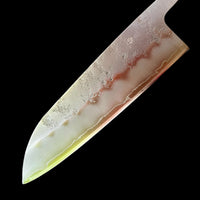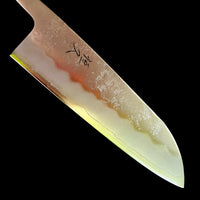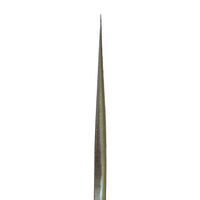Tsunehisa is a company that works with a variety of blacksmiths. The Migaki Ginsan knives are produced in Tosa, Japan.
Tsunehisa knives use high quality steels at a very reasonable price and nice fit and finish.
Ginsan (Gin3 or Silver #3) is a stainless carbon steel, with 14% added Chromium. Retaining the character of Japanese carbon steel, with similar hardness of Shirogami #2, Ginsan is stainless. It's edge retention is only slightly inferior to Shirogami #2, but the fact that it combines ease of sharpening, carbon steel character as well being stainless makes it a great choice for those who wish to have a Japanese carbon steel knife that is easy to maintain.
Specifications:
- Brand: Tsunehisa
- Location: Tosa, Japan
- Edge Steel: Ginsan 3
- Cladding: Stainless
- HRC: 61-62
- Handle: No Handle
Use & Care
- Do not attempt to cut, hit or chop frozen products or bones. The blade can chip or break with improper use.
- Hand wash with warm water and towel dry. Never put the knife in a dishwasher, nor soak it in water. Ever!
- Use a sharpening stone to maintain the sharpness of the blade.
- Do not use on hard melons or items that may torque the blade.
- Use a sharpening stone to maintain the sharpness of the blade.
- Description
Tsunehisa is a company that works with a variety of blacksmiths. The Migaki Ginsan knives are produced in Tosa, Japan.
Tsunehisa knives use high quality steels at a very reasonable price and nice fit and finish.
Ginsan (Gin3 or Silver #3) is a stainless carbon steel, with 14% added Chromium. Retaining the character of Japanese carbon steel, with similar hardness of Shirogami #2, Ginsan is stainless. It's edge retention is only slightly inferior to Shirogami #2, but the fact that it combines ease of sharpening, carbon steel character as well being stainless makes it a great choice for those who wish to have a Japanese carbon steel knife that is easy to maintain.
Specifications:
- Brand: Tsunehisa
- Location: Tosa, Japan
- Edge Steel: Ginsan 3
- Cladding: Stainless
- HRC: 61-62
- Handle: No Handle
Use & Care
- Do not attempt to cut, hit or chop frozen products or bones. The blade can chip or break with improper use.
- Hand wash with warm water and towel dry. Never put the knife in a dishwasher, nor soak it in water. Ever!
- Use a sharpening stone to maintain the sharpness of the blade.
- Do not use on hard melons or items that may torque the blade.
- Use a sharpening stone to maintain the sharpness of the blade.





